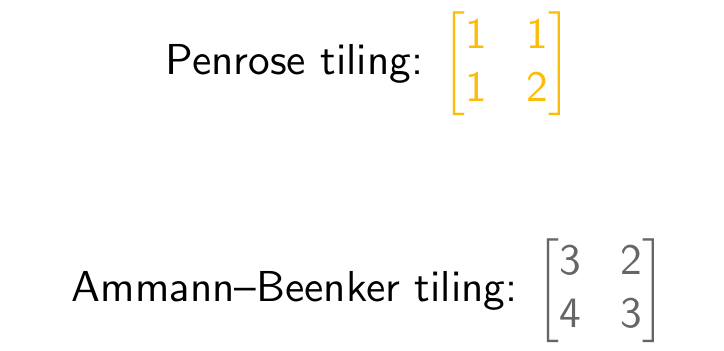Two of the most famous two-dimensional models of quasicrystals are the Penrose rhomb tiling and the Ammann–Beenker tiling. Each of these types of tiling can be used to cover the entire plane, but in an aperiodic way that has no translational symmetry.
The Penrose rhomb tiling has two basic types of rhombus-shaped tiles: narrow tiles, shown above in turquoise, and wide tiles, shown above in red. The tiling can be generated using the substitution rules shown. More precisely, each green tile is replaced by an assembly of two green and two red tiles, based on the shape of a larger narrow tile whose outline is shown in black. Simultaneously, each red tile is replaced by an assembly of two green and three red tiles, based on the shape of a larger wide tile whose outline is shown in black.
Similarly, the basic types of tiles in the Ammann–Beenker tiling are blue squares and yellow diamonds. In this case, each square is replaced by five squares and four diamonds, and each diamond is replaced by four squares and three diamonds. If we only count the fractions of tiles that appear within the black outline, it would be more accurate to say that in the Ammann–Beenker tiling, each square is replaced by 3 squares and 4 diamonds, and each diamond is replaced by 2 squares and 3 diamonds.
The corresponding counts for the Penrose tiling are that each green tile is replaced by 1 green and 1 red tile, and each red tile is replaced by 1 green and 2 red tiles. We can record this information in the form of a matrix for each tiling, as shown above.
If we compare the length of the original green tile with that of the larger outlined narrow tile that we replace it with, we find that the ratio of the lengths is the famous golden ratio, or “golden mean”, which is the number φ=(1+√5)/2. Similarly, the lengths of the original red tile and the larger outlined wide tile are in the ratio 1:φ. Something similar happens for the Ammann–Beenker tiling, but in this case, the ratio in question is the silver mean, or silver ratio, given by the formula (2+√8)/2, or 1+√2.
The table above shows that there is an infinite family of such numbers; they are known as the metallic means, or metallic ratios. The n-th metallic mean is the larger root of the quadratic polynomial x2 – nx – 1, which is given by the formula (n+√(n2 + 4))/2. The golden and silver ratios are the cases n=1 and n=2 respectively, and the third number in the series is often known as the bronze ratio, or bronze mean. It is equal to (3+√13)/2, which is approximately 3.3.
In 2017, Tomonari Dotera, Shinichi Bekku, and Primož Ziherl described a tiling based on the bronze mean, in their paper Bronze-mean hexagonal quasicrystal. In this case, there are three types of tiles, as shown above: a small triangle, coloured red or green; a big triangle, coloured turquoise or grey; and a rectangle, coloured pink, yellow, or lilac. The substitution rules for the red, turquoise, and lilac tiles are shown above. The rules for the other colours of tiles are the same, and are obtained by rotating the rules shown by 120° or 180°.
The matrix corresponding to the substitution rules for the bronze mean tiling is shown above. An unusual feature of the matrix is the presence of a non-integer entry. The numbers in the first column of the matrix signify that a small triangle is to be replaced by 1 small triangle, 3 big triangles, and 1.5 rectangles. The other columns say to replace a big triangle by 3 small triangles, 4 big triangles, and 3 rectangles; and to replace a rectangle by 4 small triangles, 8 big triangles, and 5 rectangles.
A potential problem with tilings of this type is that the tiles overlap each other, and one needs to be sure that the overlapping regions are suitably compatible. The colours of the tiles are chosen to make this relatively easy to check, and the picture above shows what happens when we apply the substitution rules to (a) a small triangle adjacent to a rectangle and (b) a big triangle adjacent to a rectangle. In each case, we find that the overlapping areas of the larger tiles are coloured in a compatible way.
The recent paper Overlapping substitutions and tilings by Shigeki Akiyama, Yasushi Nagai, and Shu-Qin Zhang makes some progress on the problem of determining whether it is possible to apply a system of substitutions to a set of overlapping tiles arbitrarily many times without running into a contradiction. The authors do not reach a firm conclusion in the case of the bronze ratio tiling, but they expect that the system of substitutions can be applied arbitrarily many times. The picture above shows the result of applying two and then three levels of substitutions to the small triangle, the big triangle, and the rectangle tiles.
Picture credits and relevant links
The pictures of the Penrose rhomb tiling and the Ammann–Beenker tiling come from the Tilings Encyclopedia.
The pictures of the substitution rules and bronze mean tilings are edited versions of pictures in the paper by Shigeki Akiyama, Yasushi Nagai, and Shu-Qin Zhang.
The other graphics are my own work.
Wikipedia has pages about Penrose tilings, Ammann–Beenker tilings, and metallic means.
Substack management by Buzz & Hum.













Can aperiodic tilings be described by point sets (Delone sets)?